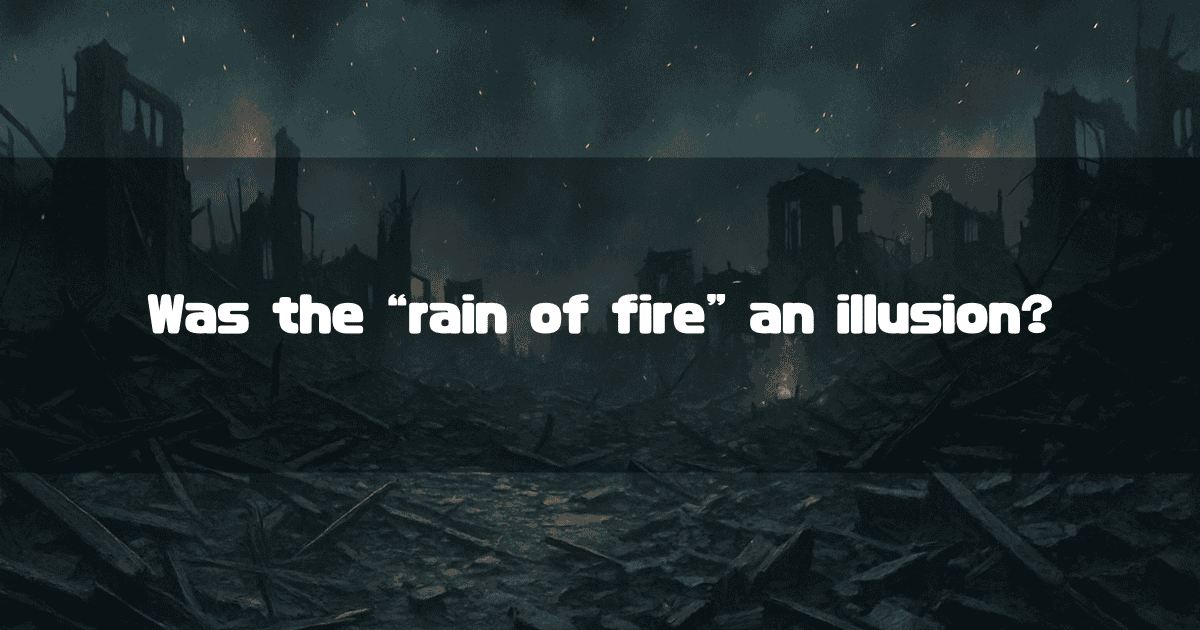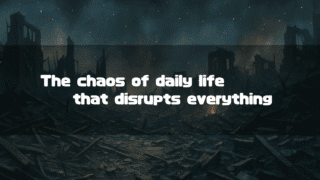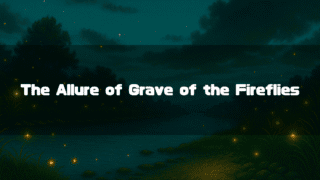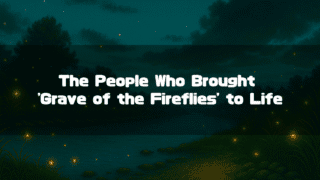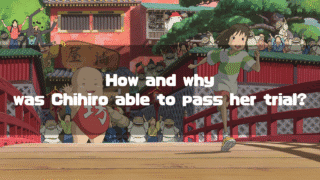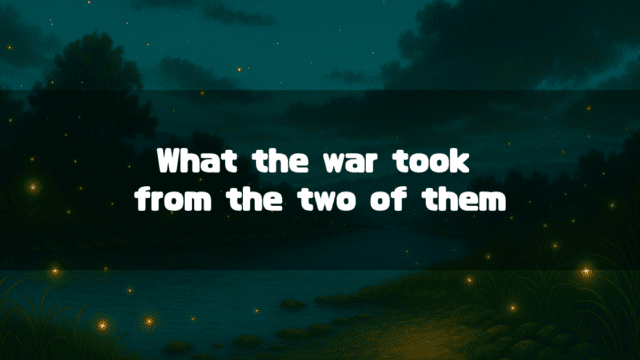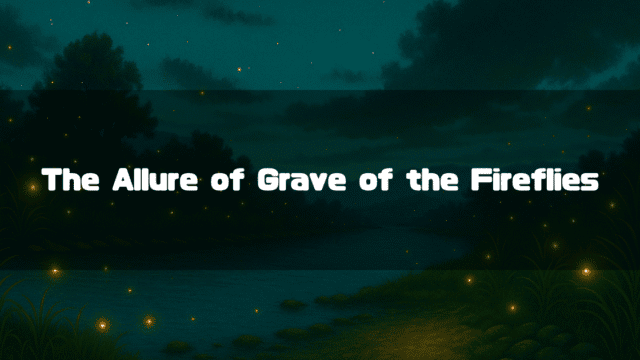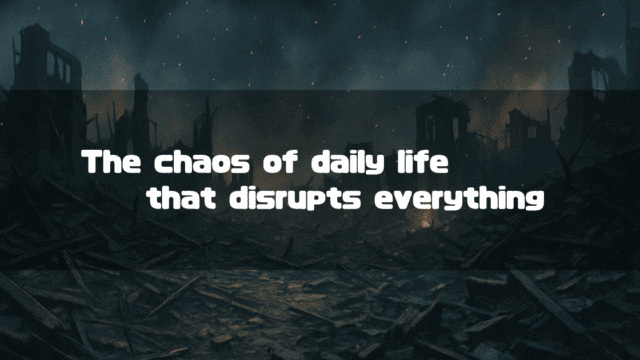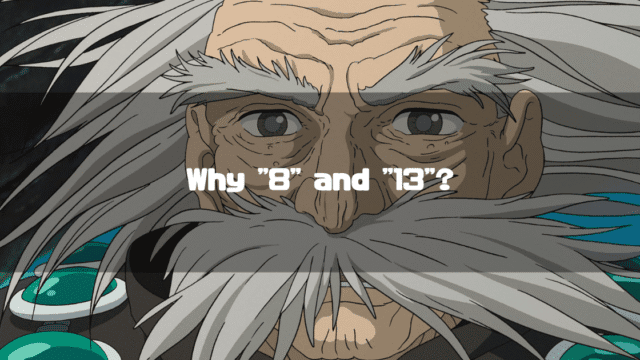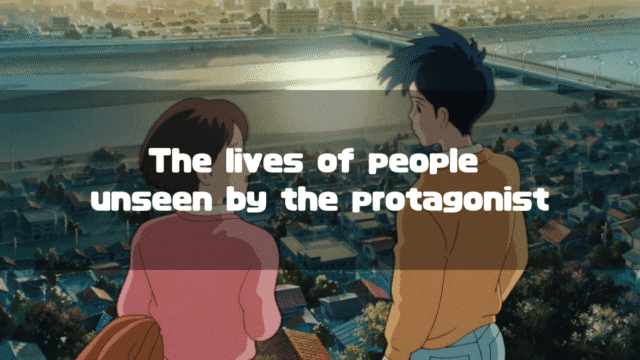“Grave of the Fireflies(Official Studio Ghibli)” is a feature-length animated film directed by Isao Takahata, released in 1988.
This article will introduce the mystery surrounding the M69 incendiary bomb depicted in “Grave of the Fireflies” and the current “answer” to it.
The core of the issue is the “problem of incendiary bombs igniting in mid-air,” a mystery born from director Isao Takahata’s commitment to accurately depicting incendiary bombs in his animation.
Director Takahata actually experienced an air raid in Okayama when he was nine years old and knew incendiary bombs from personal experience. It was truly a “rain of fire,” and such testimony is heard from many people who experienced the air raids.
Director Takahata wanted to understand the structure of the incendiary bombs and accurately depict how they fell while ignited in the air, but… when his assistant director, S-kun, asked an expert from the Japan Self-Defense Forces, he was told, “Due to their structure, it’s impossible for incendiary bombs to ignite in mid-air.”
So, what was it that people who experienced the air raids, including Director Takahata, actually saw?
The final conclusion is that the fact that “a rain of fire fell” and the seemingly contradictory fact that “it’s impossible for incendiary bombs to ignite in mid-air” can both be true. First, let’s explore the full scope of this mystery by reviewing the basic structure of an incendiary bomb.
*“Molotov’s Bread Basket” is a nickname for cluster incendiary bombs, such as the E46 used in air raids, named after Soviet politician Vyacheslav Molotov. (Reference: Wikipedia)
*This article is an English translation of the original Japanese article, “【火垂るの墓】高畑勲が犯したかもしれないミス-モロトフのパン籠を巡る謎-“
Let an AI walk you through the highlights of this post in a simple, conversational style.
-
The Precise Structure of the M69 Incendiary Bomb
The basic structure of the M69 incendiary bomb is a cluster bomb that bundles 38 individual bomblets, designed to eject napalm upon impact with the ground. -
Two Theories for the “Rain of Fire” Eyewitness Accounts
Regarding the “burning falling incendiary bombs” described by many air raid survivors, two theories are considered: the theory that “the ribbons were ignited by the explosive charge used to release the bombs,” and the theory that “the fire from the already blazing city reflected off the cloth ribbons.” However, no definitive evidence has been found. -
Differences from the Film’s Depiction and the Director’s Commitment
In “Grave of the Fireflies,” the incendiary bombs are depicted as falling as if they are the source of the fire themselves, and it appears that M69s are being dropped directly from B-29s (not as cluster bombs). While this may differ from reality, it can be interpreted as the result of Director Takahata’s attempt to faithfully recreate the perspective of a child experiencing an air raid. -
The Gap Between “Truth” and “Cinematic Depiction”
The “rain of fire” expression, based on the director’s own experiences and memories, seems to contradict official structural documents. However, it can also be seen that he prioritized the cinematic expression of “the truth as seen by the creator,” resulting in an animated work that conveys the horror and tragedy of war.
The Mystery of Molotov’s Bread Basket

The Basic Structure of an Incendiary Bomb
The incendiary bombs used in the great air raids of Kobe and Tokyo are called “M69 incendiary bombs.” The basic structure is as shown in the diagram below.

Upon impact with the ground, the fuse at the tip would ignite, ejecting the ignited incendiary agent (napalm), which became numerous fire sources that burned down houses (more vicious than you imagined, right?). The term “incendiary bomb” can be hard to grasp, but if you think of it as a “napalm bomb,” you might understand its intensity.
Actual test footage also remains.
Loading video...
Furthermore, as you can see from the video above, when incendiary bombs were dropped from a B-29, the individual bombs were not scattered one by one. Instead, a canister loaded with 38 incendiary bomblets was dropped, which then opened at an altitude of around 700 meters to disperse the bomblets (in other words, a cluster bomb).
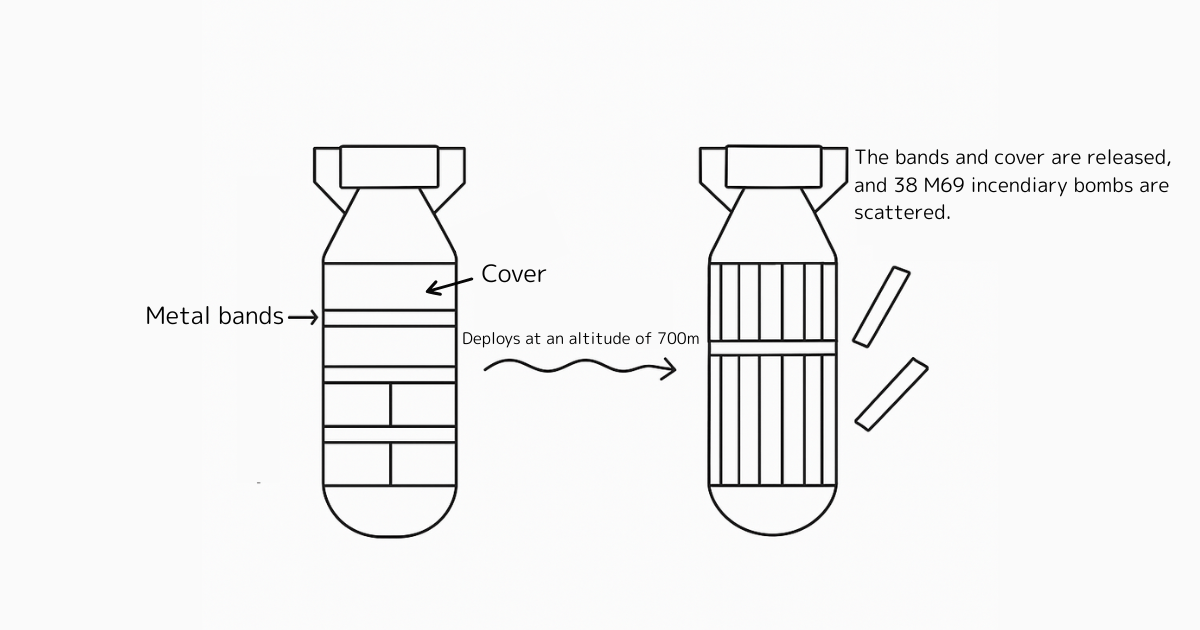
You can see this in the first part of the video above, and I think you can clearly see the cluster bombs being dropped from around the 2:35 mark in the video below.
Loading video...
With this information so far, hasn’t your image of incendiary bombs changed considerably? I myself had thought that the incendiary bomb itself was just a burning source of fire, and I didn’t know they were dropped as cluster bombs.
The Big Problem Director Takahata Faced – Mid-Air Ignition is Impossible
Director Takahata wanted to correctly express the “rain of fire” he had experienced through animation.
Above all, the title of this movie is “Grave of the Fireflies” (Hotaru no Haka), so if the incendiary bombs didn’t fall while burning, it would affect the core of the story. (The “hotaru” (火垂) in the title is a double entendre, referring to both “fireflies” (蛍) and the “rain of fire.”)
As mentioned at the beginning, when his assistant director, S-kun, asked an expert from the Self-Defense Forces about this, he was dismissed with the statement, “Due to their structure, it is impossible for incendiary bombs to ignite in mid-air.” Regarding this matter, in an essay titled “The Mystery of ‘Molotov’s Bread Basket’“ included in “Ghibli Textbook 4: Grave of the Fireflies(ジブリの教科書4:火垂るの墓, in Japanese)”, Director Takahata spoke sarcastically as follows:
Truly, the Self-Defense Forces cultivates excellent scientists. And for S-kun to say, “I was somehow convinced myself…” is just pathetic. At this rate, in this day and age where over sixty percent of the population was born after the war, I wonder if even the fact that so many people died in the air raids will be denied due to statistical errors. I feel sorry for the expert who was kind enough to help, but I was so shocked and appalled by the whole affair that I couldn’t contain my anger.
(Original Text, in Japanese)
まったく自衛隊は優秀な科学者を育てているものだ。そしてS君もまた、「ぼくもなんとなく納得してしまったんですけど・・・」とは情けない。この分では、戦後生まれが六割を超えた今日、空襲であれだけ多くの人が死んだことさえ、統計の不備によって否定されてしまうのではなかろうか。親切に対応してくれたその専門家にはもうしわけないけれど、ぼくは事の次第に驚きあきれ、怒りをおさえることができなかった。
It’s a short passage, but you can tell he was considerably angry.
However, if you consider the structure of the incendiary bomb we reviewed above, you can understand why mid-air ignition would be impossible.
If mid-air ignition had occurred, it would have been a malfunction of the incendiary bomb, but it’s hard to imagine a malfunction so widespread that air raid survivors would describe it as a “rain of fire.”
If they could ignite without the impact of hitting the ground or something similar, they would have likely burned up before even reaching the skies over Japan.
So, what was the “rain of fire” that Director Takahata and many others witnessed?
Currently, there are two proposed answers.
The True Nature of the “Rain of Fire”
What follows are two theories that are also introduced on the japanese Wikipedia page for “焼夷弾(Incendiary bomb).”
In both theories, the key point is the ribbon attached to the incendiary bomb. That ribbon was attached to improve the accuracy of the bomb’s vertical impact, and it holds the answer to the mystery.
Theory 1: The Ribbons Were Burning
The first theory is that “it was the ribbons that were burning.”
The incendiary bombs were dropped as a cluster bomb, and this theory posits that the ribbons were ignited by the explosive charge used to release the bands and cover when it reached an altitude of 700 meters.
This is written on Wikipedia, and on page 32 of the cited book, “The Complete Picture of the Air Raids on Japan(日本空襲の全貌, in Japanese)” by Masao Hiratsuka, it is written as follows:
When the “M69 cluster incendiary bomb” is dropped, the bands holding it together are released, and the M69s are scattered into the air. Then, a cloth ribbon about one meter long (a streamer) pops out to prevent the M69 from tumbling. At this time, the ribbon also catches fire, so from the ground, it looked like a rain of fire was falling.
(Original Text, in Japanese)
「M69集束焼夷弾」は、投下されると収束していた帯が解かれ、M69はバラバラに空中に放り出される。すると布製の約一メートルのリボン(ストリーマー)が飛び出してM69の揺れを防ぐ。この時、リボンにも火がつくので、地上からは火の雨が降っているように見えた。
From this description, it’s not clear for what reason the ribbon actually caught fire. It might have been due to the explosive charge for releasing the bands and cover, or there might have been a separate specification for that.
There are many descriptions of the M69 incendiary bomb itself on the web, which are very easy to understand, but there are no descriptions of the mechanism by which the cluster bomb’s bands and cover are released.
It seems the mainstream explanation for the “rain of fire” is currently the ignition of the ribbons by the explosive used to deploy the cluster bomb, but some caution is needed.
If anyone knows of materials that explain the structure of the E46 cluster bomb that bundled the M69 incendiary bombs, I would be very grateful if you could share them.
Theory 2: Flames Were Reflecting off the Ribbons
The other theory is that the light from the flames of the great fires that had already started was seen reflecting off the fluttering ribbons.
According to japanese Wikipedia, 岡山大空襲(Okayama air raid) experienced by Director Takahata began at 2:45 AM (the Tokyo Great Air Raid on March 9, 1945, also began at night).
In that case, the blazing flames would illuminate the night sky, and it wouldn’t be strange for the illuminated ribbons to appear to be glowing.
However, the great Kobe air raid, as depicted in “Grave of the Fireflies,” took place during the day. But even so, the flames that burned the entire city might have illuminated the ribbons of the falling incendiary bombs.
However, this theory also requires caution.
This is because Wikipedia only uses the expression “some theories suggest” for this idea, and even looking at the cited source, an Asahi Shimbun article titled “The Weapon that Aimed for ‘Unextinguishable Fires’: The Reality of the Incendiary Bombs Used by the US Military(『消せない火災』狙った兵器 米軍が使った焼夷弾の実態, in Japanese),” it doesn’t seem to suggest this. Reading the paid article beyond that yields the same result.
However, it is not an impossible story, and I introduced it because I thought it was a theory worth considering.
Conclusion to the Incendiary Bomb Mystery
To summarize the above:
It is impossible for an incendiary bomb to ignite in mid-air as part of its design, and malfunctions are also unlikely. However, it seems that the ribbons attached to the incendiary bombs ignited, or the fires on the ground reflected off the ribbons, making them appear to be on fire.
Director Takahata seemed dissatisfied with the Self-Defense Forces’ explanation, but I think it’s a reasonably convincing explanation. However, as mentioned above, there is still no definitive evidence to support this theory. I think it would be resolved if there were something like a specification sheet for the “E46 cluster bomb” that bundled the incendiaries, but I couldn’t find one.
The more I investigate, the deeper the mystery actually becomes.
So, in the end, how did Director Takahata depict the incendiary bombs in “Grave of the Fireflies”?
From the next section, I would like to consider this point.
The Incendiary Bombs Depicted in “Grave of the Fireflies”

The Story That Director Takahata Made a Mistake
Looking at the incendiary bombs depicted in “Grave of the Fireflies,” we can see the following:
- The ribbon part of the falling incendiary bomb is burning as it falls.
- However, there is no sign of ignited napalm being scattered; only the bomb’s casing appears to be the source of the fire, and no ribbons are visible.
- There is no explosion upon impact with the ground (there is a metallic sound of the bomb hitting, but no explosion sound).
- It looks as if M69 incendiary bombs are being dropped directly from the B-29s.
From a modern perspective, one could say Director Takahata adopted the “ignition of the ribbons” theory, but since there’s no sign of ribbons on the bombs that have landed, nor is there any napalm being scattered from them, it seems the director believed that the napalm ignited in mid-air and the bomb itself became the source of the fire.
Whether what was dropped from the B-29s were cluster bombs or M69 incendiaries is debatable, but to my eyes, it looked like M69s were being dropped directly.
Looking at it overall, couldn’t one take the view that Director Takahata made a mistake?
But to end the story here would be a bit crude. Why did the master Isao Takahata go so far as to ignore the experts from the Self-Defense Forces to draw an “incorrect incendiary bomb”? Let’s think about that.
The Story That Director Takahata Did Not Make a Mistake
The reason there appears to be a slight “mistake” in the expression chosen by Director Takahata, despite going so far as to ask an expert from the Self-Defense Forces about the structure of incendiary bombs, is likely because he valued his own experience and subjectivity.
Of course, one could criticize that. However, I also think “Grave of the Fireflies” is a film that should be watched with the understanding that it may differ from the facts.
And this is not limited to “Grave of the Fireflies”; for example, if you read Ryotaro Shiba’s “Ryoma ga Yuku” and believed everything was fact, that would be your mistake.
Not uncritically accepting what is depicted in a work as fact is a general rule for works depicting the “past” (of course, I say this with a sense of self-admonition).
On that basis, if there is something we should take away from watching “Grave of the Fireflies,” it would be Director Takahata’s truth of “This is how it was!”
As someone who actually experienced air raids and the war at the age of nine, perhaps Isao Takahata wanted to visualize that subjective “truth.”
It may differ from the facts, but it is what Director Takahata saw and felt. Part of the background for wanting to adapt “Grave of the Fireflies” into a film might have been a desire to create something with such an autobiographical aspect.
If you think of it this way, you could say that Director Takahata didn’t make a mistake by depicting something different from the facts, but rather that he accurately visualized his own truth.
The above is what I have personally researched and thought about regarding the “Mystery of Molotov’s Bread Basket” surrounding the depiction of incendiary bombs in “Grave of the Fireflies.”
It is, after all, a sensitive work in that it depicts an era of war, but I also feel like I’ve come to understand the difficulty of accurately visualizing things from the past.
What do you all think about the way incendiary bombs are depicted in “Grave of the Fireflies”?
About the Author
Recent Posts
- 2025-09-16
Maleficent: Full Synopsis and Analysis – A Tale That Complements and Corrects the “Questionable Points” of Sleeping Beauty - 2025-09-15
An Analysis of Disney’s “Sleeping Beauty”: Plot Spoilers, Its Enduring Charm, Lovable Nitpicks, and Differences from the Original Tale - 2025-09-06
The Boy and the Heron: Characters, Voice Actors & Analysis - 2025-09-06
The Boy and the Heron: Full Synopsis & Analysis (Spoilers Explained) - 2025-09-06
The Boy and the Heron: The Amusing “Fraud” Legends of Toshio Suzuki, the Model for the Gray Heron – The History of the Masterful Skill that Supported Studio Ghibli –

